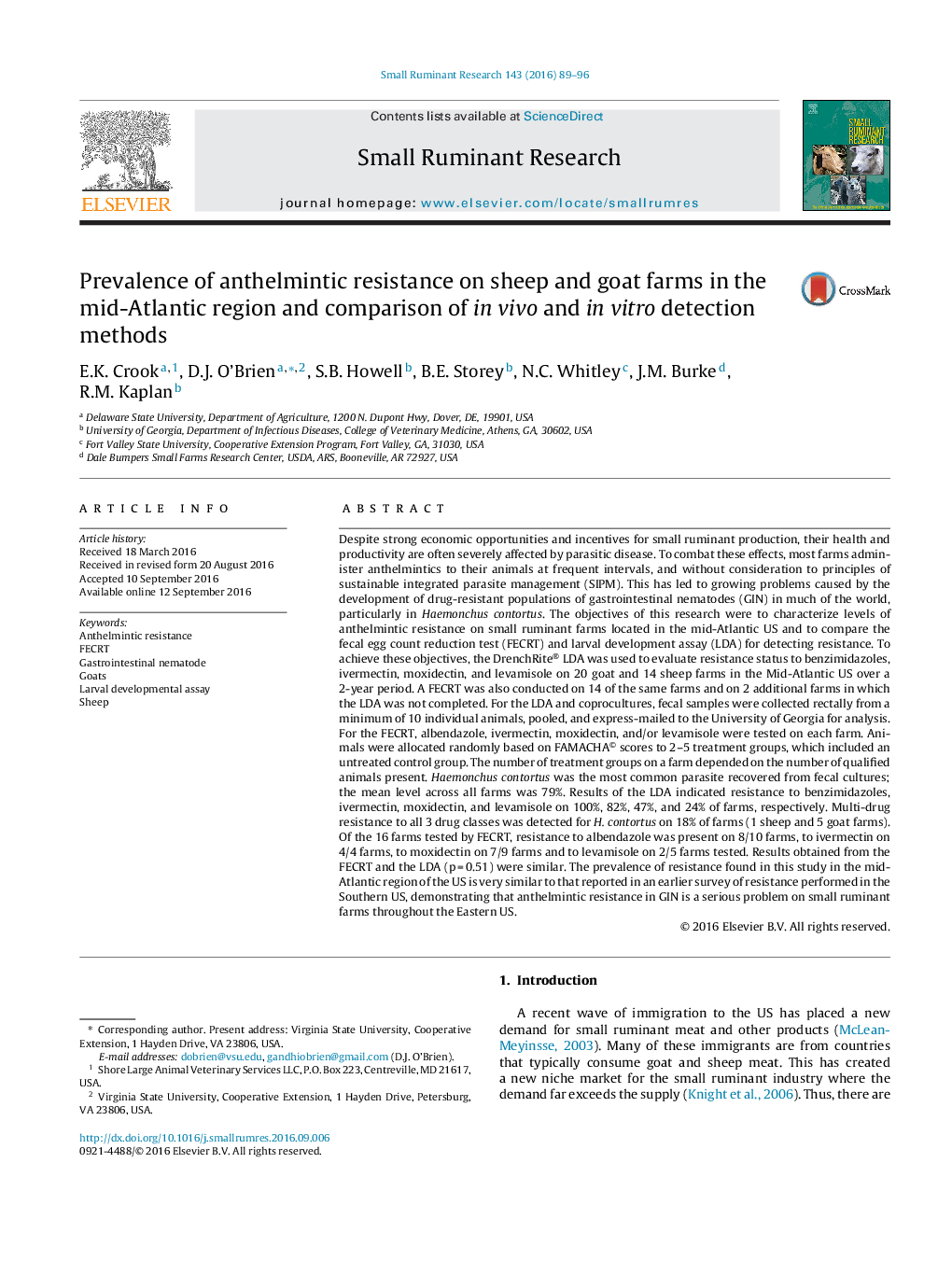| کد مقاله | کد نشریه | سال انتشار | مقاله انگلیسی | نسخه تمام متن |
|---|---|---|---|---|
| 8504421 | 1554349 | 2016 | 8 صفحه PDF | دانلود رایگان |
عنوان انگلیسی مقاله ISI
Prevalence of anthelmintic resistance on sheep and goat farms in the mid-Atlantic region and comparison of in vivo and in vitro detection methods
دانلود مقاله + سفارش ترجمه
دانلود مقاله ISI انگلیسی
رایگان برای ایرانیان
کلمات کلیدی
موضوعات مرتبط
علوم زیستی و بیوفناوری
علوم کشاورزی و بیولوژیک
علوم دامی و جانورشناسی
پیش نمایش صفحه اول مقاله

چکیده انگلیسی
Despite strong economic opportunities and incentives for small ruminant production, their health and productivity are often severely affected by parasitic disease. To combat these effects, most farms administer anthelmintics to their animals at frequent intervals, and without consideration to principles of sustainable integrated parasite management (SIPM). This has led to growing problems caused by the development of drug-resistant populations of gastrointestinal nematodes (GIN) in much of the world, particularly in Haemonchus contortus. The objectives of this research were to characterize levels of anthelmintic resistance on small ruminant farms located in the mid-Atlantic US and to compare the fecal egg count reduction test (FECRT) and larval development assay (LDA) for detecting resistance. To achieve these objectives, the DrenchRite® LDA was used to evaluate resistance status to benzimidazoles, ivermectin, moxidectin, and levamisole on 20 goat and 14 sheep farms in the Mid-Atlantic US over a 2-year period. A FECRT was also conducted on 14 of the same farms and on 2 additional farms in which the LDA was not completed. For the LDA and coprocultures, fecal samples were collected rectally from a minimum of 10 individual animals, pooled, and express-mailed to the University of Georgia for analysis. For the FECRT, albendazole, ivermectin, moxidectin, and/or levamisole were tested on each farm. Animals were allocated randomly based on FAMACHA© scores to 2-5 treatment groups, which included an untreated control group. The number of treatment groups on a farm depended on the number of qualified animals present. Haemonchus contortus was the most common parasite recovered from fecal cultures; the mean level across all farms was 79%. Results of the LDA indicated resistance to benzimidazoles, ivermectin, moxidectin, and levamisole on 100%, 82%, 47%, and 24% of farms, respectively. Multi-drug resistance to all 3 drug classes was detected for H. contortus on 18% of farms (1 sheep and 5 goat farms). Of the 16 farms tested by FECRT, resistance to albendazole was present on 8/10 farms, to ivermectin on 4/4 farms, to moxidectin on 7/9 farms and to levamisole on 2/5 farms tested. Results obtained from the FECRT and the LDA (p = 0.51) were similar. The prevalence of resistance found in this study in the mid-Atlantic region of the US is very similar to that reported in an earlier survey of resistance performed in the Southern US, demonstrating that anthelmintic resistance in GIN is a serious problem on small ruminant farms throughout the Eastern US.
ناشر
Database: Elsevier - ScienceDirect (ساینس دایرکت)
Journal: Small Ruminant Research - Volume 143, October 2016, Pages 89-96
Journal: Small Ruminant Research - Volume 143, October 2016, Pages 89-96
نویسندگان
E.K. Crook, D.J. O'Brien, S.B. Howell, B.E. Storey, N.C. Whitley, J.M. Burke, R.M. Kaplan,